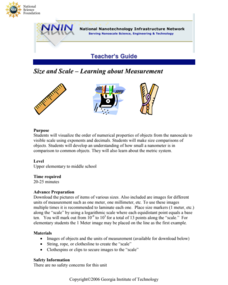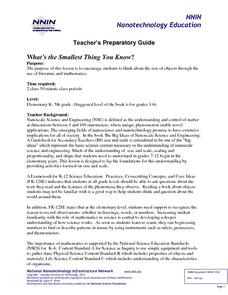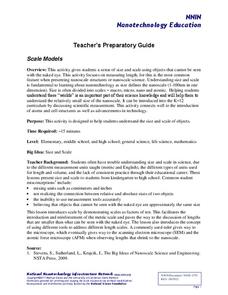National Nanotechnology Infrastructure Network
Size and Scale – Learning about Measurement
Can you visualize one billionth of a meter? It's not easy to understand the scale of a nanometer. Learners use a hands-on lesson to develop an understanding of the size of a nanometer in comparison to common objects. They walk away with...
National Nanotechnology Infrastructure Network
How Can Nanoparticles Move from Land to Ocean?
Investigate the migration of the nanoparticle from land to water! A lab investigation asks budding scientists to simulate runoff. Testing water samples before and after the simulation leads individuals to make conclusions about pollution...
National Nanotechnology Infrastructure Network
Gelatin Microfluidics
Micro what? Analyze microfluidics as an application in the medical community. A lab investigation highlights the importance of channel design in biotechnology. Learners modify channels and observe the behavior of the flow of the fluids.
National Nanotechnology Infrastructure Network
Big vs. Little - Macro to Micro Lesson 1
Small and large are relative terms; what's the best way to quantify them? Young scientists take on that challenge as they complete an interactive activity to explore size. They build structures during their exploration and begin using...
National Nanotechnology Infrastructure Network
Big vs. Little - Macro to Micro Lesson 3
A nanometer is the approximate distance your fingernail grows in one second. Hard to visualize, isn't it? The third of a five-part lesson on scale seeks to help learners understand the size of the nanoscale of measurement. Using examples...
National Nanotechnology Infrastructure Network
Big vs. Little - Macro to Micro Lesson 5
It is a long way from nano to macro. Learners examined the scale of measurement from macro to nano in the first four lessons of the five-part series. With the final installment, they review what they learned by classifying objects in one...
Virginia Department of Education
Prokaryotes
Lead your biology class on a cell-sized adventure! Emerging scientists construct models of prokaryotes, then design an experiment to properly grow a bacterial culture. They conclude the activity by viewing the culture under a microscope....
Curated OER
Nanofibers: Measuring the Visible to Understand the Invisible
Students compare the size and shape of tubes that can be measured, to the size and shape of "nanowhiskers" that are too small to see. They practice measuring, calculating and graphing the ratio of circumference to diameter of a circle,...
Institute of Electrical and Electronics Engineers
Waterproof that Roof!
Learners design and build model houses, with an emphasis on waterproof roofs. They perform tests to see if their models are as waterproof as they think.
National Nanotechnology Infrastructure Network
Noodling Around: Powers of Ten
How many noodles long is your classroom? Find out when engineers of all ages explore measurement through the use of pool noodles. With the noodles pre-cut to certain metric lengths, the activities could be used to introduce the metric...
Curated OER
Nanofibers: Why Go Small?
Young scholars explain the advantages of nanotechnology. In this chemistry lesson, students investigate pretzels' average diameter and circumference. They graph their result and compare with other groups.
SRI International
Nanofiltration
How can everyone in the world have access to clean drinking water? Throughout the lesson, learners read about and listen to how water is filtered, what the filtration process removes, and the best ways to filter. They explore the...
National Nanotechnology Infrastructure Network
Is Measuring an Art or a Science?
Not only do future engineers learn the difference between accuracy and precision, they also get some hands-on experience using different measuring tools.
National Nanotechnology Infrastructure Network
Powers of Ten with the Blue Morpho Butterfly
Explore the powers of ten while examining a Blue Morpho butterfly wing. Learners discover there is a lot more than meets the eye when one looks close enough.
National Nanotechnology Infrastructure Network
What’s the Smallest Thing You Know?
Elementary learners listen to a story, then sort objects from largest to smallest at six different stations around the classroom. Adaptable for a large range of age and ability groups.
National Nanotechnology Infrastructure Network
Scale Models
With instructions to adapt the activities for any grade K-12, any teacher can incorporate the concept of scale into the classroom with a simple, yet effective lesson.
Cornell University
Atomic Bonding
Explore the connection of surface area to bonding within atoms. Learners complete lab investigations to model changing surface area with different sizes and concentrations of atoms. A flour fireball demonstration follows the labs to...
Science Friday
Microorganisms on the Move
You can't b. cereus until you see this lesson! Young microbiologists learn to prepare deep well slides, observe two types of microorganisms, and compare and contrast their physical characteristics in this interactive and lively activity.
National Nanotechnology Infrastructure Network
Physical Science Reference Sheet
Need a quick reference sheet for a physical science class? A helpful single-page sheet contains the periodic table of elements, a chart of metric prefixes, a display of the electromagnetic spectrum, and several physical science formulas.
National Nanotechnology Infrastructure Network
Taking a Closer Look at Objects
Take a close look at the world around you with an activity that magnifies everyday objects. Five explorations examine items under intense magnification and pose a series of questions that encourage critical thinking and following...
National Nanotechnology Infrastructure Network
The Right Tool for the Job
Is a saw a tool? What about a thermometer? Discover the applications of various tools with a worksheet that accompanies a matching card game. Learners search for tools from a stack of cards and circle its match on their worksheet.
National Nanotechnology Infrastructure Network
Making a Liquid Crystal Thermometer
Introduce your classes to a fourth state of matter! Liquid crystals have a colorful sheen that changes based on different physical factors. Learners use this information to create a liquid crystal thermometer where the color of the...
National Nanotechnology Infrastructure Network
Small Scale Stenciling: Mask Lab
Investigate the procedure for developing computer chips! Learners use solar print paper to create both positive and negative images. They observe the effects of single and multiple exposures and compare results.
National Nanotechnology Infrastructure Network
Hiding Behind the Mask
Microchips are a man-made wonder. Investigate the manufacturing wonder with a hands-on inquiry-based lesson. Scholars simulate the process of pattern transfer using photoresist. Their conclusion identifies how their process replicates...
Other popular searches
- Nanotechnology Medicine
- Chemistry Nanotechnology
- Nanotechnology Worksheet
- Nanotechnology Article
- Nanotechnology Nuclear
- Nanotechnology Lessons
- Science 5 E's Nanotechnology
- Nanotechnology \ Medicine

























